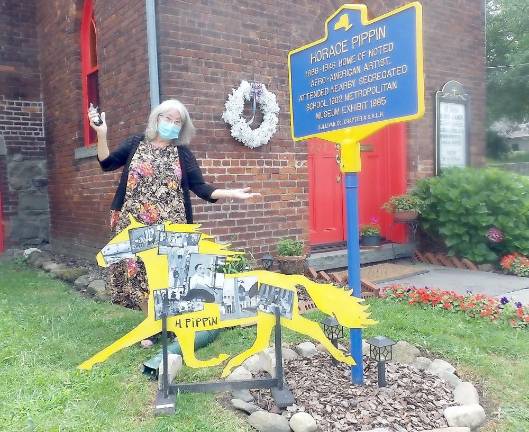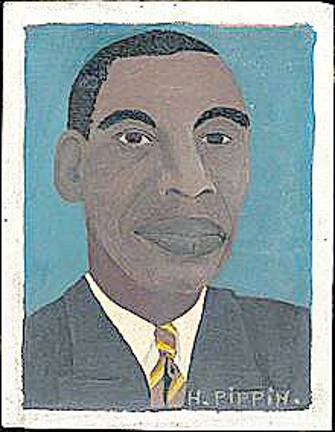Goshen. ‘My Painted Trotter was used to place Horace Pippin as an artist and Black man within today’s context’


This is how Jacqueline O’Malley-Satz approached her Painted Trotter:
“The design problem was ‘How do I use the outline of the trotter to augment my theme or visa versa? From the many submissions people handled it in a number of ingenious ways. Some used the idea of a ‘blank’ canvas and painted lovely objects within the space, some used it to paint the ‘trotter’ as an actual ‘horse.’ Some used it to make a statement. Mine was more the last.
“Horace Pippin had grown up in Goshen and many can say they know or heard of the painting ‘The Milkman of Goshen’ and they knew he grew up here and they know of the historic marker in front of the AM Church. But do they know the rest of the story?
“He grew up at the beginning of the last century and lived in Goshen from around 1903 to 1916. He went to a segregated school (the building still exists in the neighborhood but is now a private home).
“As a young boy he won an art contest and his prize was art supplies. He worked for a few local establishments doing a variety of odd jobs to help his mother. Eventually he went to War and fought with the segregated group called the Harlem Hellfighters and was awarded the Croix de Guerre. He was wounded and as a result needed to use his left hand to guide his painter’s hand to work.
“He was self-taught and used his paintings sometimes as barter and sought out opportunities to show them in local store fronts. Eventually, Andrew Wyeth saw them and brought an art critic friend to look at them. They helped catapult the opportunity to exhibit more and to be noticed. Today, we can see the chronicle of his life within the history of his times by going to the most prestigious museums in the country since all 146 paintings are in their collections.
“My Painted Trotter was used to place Horace Pippin as an artist and Black man within today’s context.
“I wanted to show proof of his art connecting to our local and current history in the making. His painting of his World War I and the reflections on the horrors of war, ‘Mr. Prejudice,’ a commission showing the ‘V’ for victory with a huge man going to hammer the middle.
“The one we all know is ‘The Milkman of Goshen’ which shows a common ordinary day in Goshen when folks came to buy milk.
“We all can learn a lot from this local personage and I hope that this piece will inspire our pride in this place we live and the people who have made the most of their lives here.”